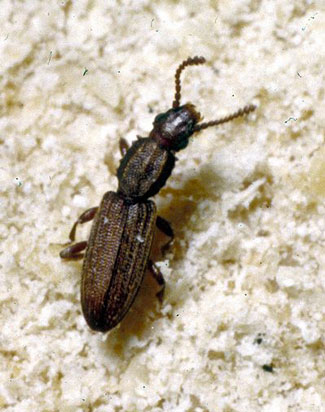Why the Sawtoothed Grain Beetle is a Top Pantry Pest
By Chris Williams on October 24, 2014.

Sawtoothed Grain Beetle
Although the Indian meal moth is probably our most important pest of stored foods in homes, a close second is the sawtoothed grain beetle. This is a very tiny (less than 1/8 inch long), brown beetle. If you can look at it under magnification, you will see that there are 6 “sawteeth” on each side of its thorax. The beetle tends to wander away from its food source, while the tiny, whitish, wormlike larva spends all of it time in the food package.
Getting rid of a sawtoothed grain beetle infestation is a challenge because:
1. They eat anything
Unlike some stored food pests that specialize in certain types of foods, sawtoothed grain beetles feed on almost anything, which makes it hard to narrow down your search. You pretty much have to check all food packages. The foods most likely to be infested are processed foods that are old and already damaged. Look for products that have been stored and not moved for along time, usually those on the back of a shelf (see How to Check Food Products for Insects – Advice From the Pros). Because sawtoothed grain beetles feed on many different things, don’t forget to check dry pet food, bird seed, fish food, and rodent bait.
2. They’re scavengers
Sawtoothed grain beetles are considered to be secondary invaders or scavengers. We usually say that one of the things they won’t infest is whole grains or dried beans or peas because their jaws are not strong enough to break through the outer kernels. But sawtoothed grain beetles often infest these foods after other insects have done the initial damage. If weevils or grain borers have already bored into the whole kernels, sawtoothed grain beetles will infest them as well to feed on the debris left by others.
3. They squeeze into packages
The beetles are very flattened which allows them to squeeze into cracks and crevices, and into sealed food packages. That’s why you need to check even unopened packages. They are quite capable of squeezing between cardboard flaps and chewing through plastic bags to get into a food box or bag.
4. All stages feed
For many of our serious stored food pests, only the larval form is responsible for the feeding damage. But both the larva and the adult sawtoothed grain beetle feed on stored foods so damage can happen quickly. When fully grown, the sawtoothed grain beetle larva covers itself with food particles and pupates in the food material.
Sawtoothed grain beetles are very successful at what they do for all of the reasons listed above. If you find a lot of tiny, brown beetles wandering around your kitchen, do yourself a favor and call an exterminator. You don’t stand a chance against these guys!
By Clemson University – USDA Cooperative Extension Slide Series, Bugwood.org [CC-BY-3.0], via Wikimedia Commons
Sign up for our biweekly email newsletter for more information about bugs and pests!